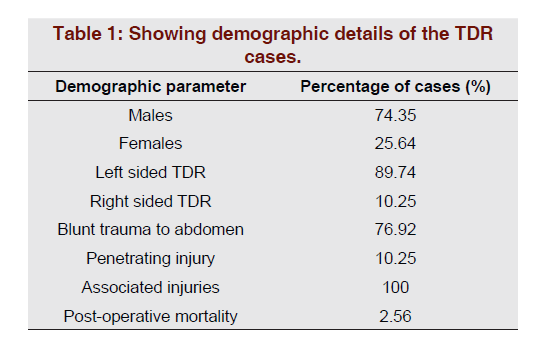A Retrospective Study of Traumatic Diaphragmatic Hernia in Rajasthan
DOI:
https://doi.org/10.5530/jcram.1.2.11Keywords:
Traumatic diaphragmatic hernia, Thoracotomy, Cardiothoracic surgery, Traumatic diaphragmatic rupture, Injuries, Traumatic, Diaphragmatic HerniaAbstract
Introduction: Diaphragmatic injuries occur in 3.9 % of chest injuries. Traumatic diaphragmatic hernia usually undergo unrecognized. Diagnosis of diaphragmatic injuries is usually difficult. Materials and Methods: The records of patients who got operated for traumatic diaphragmatic hernia in the Department of Cardio- Thoracic and Vascular Surgery at SMS Hospital, Jaipur between July 2012 to July 2019 were referred. 39 patients underwent surgery for diaphragmatic hernia. From records history, age, sex, symptoms, signs, chest X-ray finding, operative approach for repair, operative course and outcome were recorded. Results: From 2012 July to 2019 July, 39 patients were operated by thoracotomy for traumatic diaphragmatic injury of which 29 were males and 10 were females. The oldest patient was 60 years old and the youngest was 12 years old. The cause of rupture of diaphragm was blunt abdominal trauma in 30 cases, penetrating chest trauma was seen in 9 cases. 33 cases gave history of road traffic accidents, 6 had fallen from height. Left sided tear was seen in 35 cases whereas 4 patients had right sided rupture. Most common symptom was difficulty in breathing seen in 34 cases. Reduced air entry was seen in 39 cases. The diagnosis of diaphragmatic hernia was made on the basis of history, clinical examination of chest X-ray with ryles tube in situ in 36 cases, whereas 3 case required CECT. Conclusion: Traumatic diaphragmatic hernia requires high index of suspicion for diagnosis, investigation most commonly chest x ray with ryles tube. It is more common in males and usually left sided. Early and prompt surgical repair by thoracotomy is the treatment of choice. The following core competencies are addressed in this article: Patient care and Procedural skills, Medical knowledge, and System-based practice.

Downloads
Published
How to Cite
Issue
Section
License
JCRAM and its contents are licensed under a Creative Commons Attribution-Non Commercial-No Derivs 4.0 License. Permissions beyond the scope of this license may be available with editor@jcramonline.com






